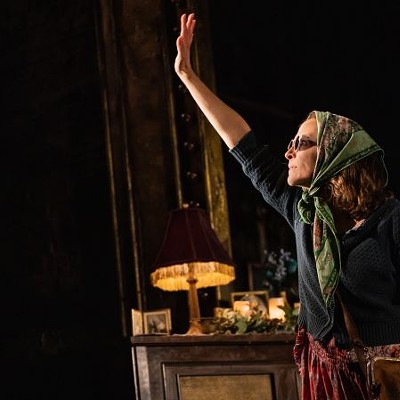It's a perfect story, with roots deep in the Houston Public Library archives: a famous Houstonian, a piece of microfilm, crime photographs from over a half-century ago, and an intrepid researcher digging up the dirt.
That famous Houstonian is none other than Marvin Zindler, and while the real story might not be as sordid as it sounds, it certainly sheds some light on a seldom-known past of the beloved journalist. "Bayou City Noir," the upcoming installation at Houston's Museum of Printing History, features a collection of Zindler's crime photography from the early 1950s, when he worked as a freelancer for the Houston Press.
No, not this Houston Press - the outlet Zindler worked for was a Scripps-Howard paper that closed after the Houston Chronicle bought it in the 1960s.
The exhibition developed after John Gonzales, a copy editor at the Chronicle and writer of its Bayou City History blog, stumbled across one of the photos while researching for a post. "I just happened to find this photograph in the [old] Houston Press of this woman who had been a crime victim at the Alabama Theater," Gonzales explains. "When I looked at the photo credit, I noticed it was taken by Marvin Zindler."
Shocked by the discovery, Gonzales immediately pondered whether there were more photos taken by Zindler. "I looked on the microfilm, and sure enough there were some great dramatic photos that Marvin had taken," he says. "It started from there. At one point, I just decided we've got to share these photos with the public somehow."
From there he set about gathering more of Zindler's photographs, searching extensively in the Houston Metropolitan Research Center of the Houston Public Library. "[It] was just a matter of going through the old Houston Press archives," says Gonzales, "going through every photo figuring out which ones Marvin took, and which ones were printed. Once I managed to identify Marvin's photos in that collection and I figured out that we had enough for an exhibition, I decided to contact the family."
The bulk of the images that will be on display were found at the library, but the Zindler family contributed some additional items - including some tear sheets Marvin had saved from his freelancing days. Approximately 50 photos comprise the exhibition, which opens to the public on March 24th.
In assembling the installation, Gonzales has brought three of his interests together - Houston history, photography, and the history of local journalism - in hopes of shedding a new light on our famous white-haired, blue-shades-sporting citizen, as well as the crime-laden period when Zindler was shooting.
"When we think of Houston in the '50s, maybe we think of the Shamrock [Hilton Hotel], and its growing into a boomtown," says Gonzales. "But this provides a different look, at the seedier side of Houston in the early '50s, through the eyes of Marvin Zindler...back then, the city was known as the murder capital of the nation. It had a very high crime rate, and Marvin was right in the middle of it." According to Gonzales, Houston journalists were reporting murders daily.
Houston's crime rate was being reported across the nation as well. Robert C. Ruark, writing about Houston's murderous notoriety for Washington state's Tri County Herald, notes, "There is no second day story on a murder here because there is always a better murder story for tomorrow...Yesterday's crop of lethal kisses wither before the fresher fruit of today's gunfire." Ruark goes on: "Nobody seems to be able to explain the penchant of the Houstonian for outing with his haw-leg and blasting a little daylight into a firm friend or drunken companion." ("The Murder Capital Of The World," Tri City Herald, May 14th, 1952.)
The images in "Bayou City Noir" also offer a look at Houston icon Zindler back to when he was in his early 30s. Those only familiar with him via KTRK Channel 13 may be surprised by the image of him holding an old Speed Graphic camera, prior to his numerous plastic surgeries.
"Marvin was a very talented individual, he was very creative, and he wasn't afraid to try his hand at something new; this is just one example of that," says Gonzales. "Everyone who knows Marvin knows he had a very diverse career, from the sheriff's department to Channel 13 and his humanitarian work, but no one knew that he was a freelance newspaper photographer. It's kind of a reassessment of him; it proves how diverse he could be."
"Bayou City Noir: The Photography of Marvin Zindler" opens on March 24th, 2011 and will be on display until August 13th, 2011 at The Museum Of Printing History. An opening reception will be held on March 24th from 6-8 pm.
The Museum Of Printing History 1324 West Clay Street Houston, TX 77019 713.522.4652 http://www.printingmuseum.org
Follow Art Attack on Facebook and on twitter ArtAttackHP





